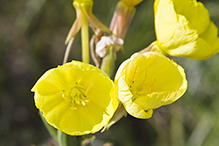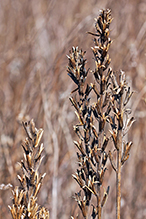common evening primrose
(Oenothera biennis)
Conservation • Wetland • Description • Habitat • Ecology • Use • Distribution • Taxonomy
Description |
||
Common evening primrose is an erect, biennial forb that rises usually on a single stem from a fleshy taproot. It can be up to 80″ tall, though it is usually much shorter. In the first year it forms a rosette of basal leaves. In the second year it sends up a flowering stem. It dies after bearing fruit once. The rosette leaves are green to pale green, stalked, narrowly inversely lance-shaped or lance-shaped, 4″ to 12″ long, and ¾″ to 2″ wide. The blade is broadly or narrowly angled at the tip and tapers gradually to the leaf stalk at the base. The upper and lower surfaces are covered with minute, straight, sharp, stiff, appressed hairs. The margin is toothed. The teeth are sometimes blunt, sometimes widely spaced. The lower part of the blade sometimes has broad, wavy teeth or is lobed. The stem is erect, green, leafy, and sometimes flushed with red near the base. It may be unbranched or have a few branches rising from the rosette or a few branches on the main stem. It is densely to sparsely covered with minute, straight, sharp, stiff, appressed hairs, and also with longer, somewhat appressed to spreading hairs. Stem leaves are alternate, narrowly inversely lance-shaped to lance-shaped or narrowly elliptic to elliptic, 2″ to 8½″ long, and ⅝″ to 2″ wide. The blade is narrowly angled at the tip and wedge-shaped or tapered at the base. They are otherwise similar to rosette leaves. There is often a cluster of smaller, secondary leaves in the axil of the leaf. The inflorescence is a stiff, relatively open spike of numerous flowers at the end of the stem and branches. The spike is unbranched but there is often a secondary spike below the main one. The central axis of the spike (rachis) sometimes red. It is densely to sparsely covered with minute, straight, sharp, stiff, appressed hairs, and also with longer, somewhat appressed to spreading hairs. The individual flowers are stalkless. What appears to be a stalk is, in fact, an elongated ovary surmounted by a hypanthium, a floral tube formed by the fused bases of the sepals, petals, and stamens. The floral tube is yellowish-green, sometimes flushed with red. It is sparsely to densely covered with short, straight, glandular hairs and also sparsely covered with long, soft, shaggy hairs. When in bud it is 1″ to 1 9 ⁄16″ long, 1 ⁄32″to 1⁄16″ in diameter, widely spreading near the rachis then strongly ascending, with the bud held upright. When in bloom the floral tube elongates, straightens somewhat, and the flower is held at about a 45° angle. The flowers are crowded and 1″ to 2″ in diameter when fully open. There are 4 sepals, 4 petals, 8 stamens, and 1 style. The sepals are yellowish-green, linear, ½″ to ⅞″ long, and strongly bent backward along the hypanthium. The petals are yellow, rarely pale yellow, very broadly egg-shaped, ½″ to 1″ long, and 9 ⁄16″ to 1 1 ⁄16″ wide. They are broadly rounded and notched at the tip. They fade to orange as they begin to wither. The stamens extend only slightly beyond the corolla. They have 5 ⁄16″ to ⅝″ long filaments and ⅛″ to ¼″ long anthers. The style has a distinctive, 4-lobed, cross-shaped stigma. The flowers open around sunset and close by noon except on cloudy days, when they remain open. They change from closed to fully open in just one minute. They are pollinated by hawk moths or sphinx moths, which feed on their nectar at night. The hypanthium, petals, and sepals are deciduous, withering and falling off when the fruit is formed. The flowers have a mild lemony scent. The fruit is a cylinder-shaped, ¾″ to 1 9 ⁄16″ long, ⅛″ to ¼″ in diameter, 4-celled capsule. The capsule is green, stalkless; bluntly 4-angled with rounded angles; thickest at the base and tapered toward the tip; and straight, not curved near the base. Each cell of the capsule contains two rows of dark brown, egg-shaped seeds. The seeds do not have a tuft of hairs (pappus) at the top. |
||
Height |
||
20″ to 80″ |
||
Flower Color |
||
Yellow |
||
Similar Species |
||
Cleland’s evening primrose (Oenothera clelandii) is a smaller plant, no more than 40″ in height. The flowers are smaller and have diamond-shaped petals. The seed capsules are smaller and are curved. Cut-leaved evening primrose (Oenothera laciniata) is a short plant, reaching only 18" at maturity. The leaves are lobed. Northern evening primrose (Oenothera parviflora) has smaller flowers, no more than one inch wide. Nuttall’s evening primrose (Oenothera nuttallii) has white flowers. Perennial evening primrose (Oenothera perennis) is a shorter plant, reaching only 24″ at maturity. It has smaller flowers, ⅓″ to ¾″ wide. Rhombic evening primrose (Oenothera rhombipetala) flower has diamond-shaped petals. Toothed evening primrose (Oenothera serrulata) is a much shorter plant, reaching only 24″ at maturity. It is usually found with clustered stems, which may be woody at the base. The leaves are toothed, and are linear or oblong and narrow. |
||
Habitat |
||
Dry to moderate moisture. Prairies, fields, thickets, roadsides, railroads, disturbed sites and waste places. Full sun. |
||
Ecology |
||
Flowering |
||
June to October |
||
Pests and Diseases |
||
|
||
Use |
||
|
||
Distribution |
||||
|
Sources |
|||
| 3/24/2023 | ||||
Nativity |
||||
Native |
||||
Occurrence |
||||
Common and widespread |
||||
Taxonomy |
|||
| Kingdom | Plantae (Plants) | ||
| Division | Tracheophyta (Vascular Plants) | ||
| Subdivision | Spermatophytina (Seed Plants) | ||
| Class | Magnoliopsida (Dicots) | ||
| Order | Myrtales (Myrtles, Evening Primroses, and Allies) | ||
Family |
Onagraceae (Evening Primrose) | ||
| Subfamily | Onagroideae | ||
| Tribe | Onagreae | ||
Genus |
Oenothera (Evening Primroses, Sundrops, and Beeblossoms) | ||
| Section | Oenothera | ||
| Subsection | Oenothera | ||
Subordinate Taxa |
|||
|
|||
Synonyms |
|||
Oenothera biennis ssp. caeciarum Oenothera biennis ssp. centralis Oenothera biennis var. pycnocarpa Oenothera muricata Oenothera pycnocarpa |
|||
Common Names |
|||
common evening primrose common evening-primrose evening primrose evening-primrose fever-plant German rampion German-rampion hoary eveningprimrose hog weed king’s cure-all weedy evening-primrose |
|||
The family name refers to the flowers which are partially to fully closed during the day, open in the evening, and close at noon. The plants are pollinated by hawk moths and sphinx moths, which feed on their nectar at night. |
|||
Glossary
Axil
The upper angle where a branch, stem, leaf stalk, or vein diverges.
Corolla
A collective name for all of the petals of a flower.
Filament
On plants: The thread-like stalk of a stamen which supports the anther. On Lepidoptera: One of a pair of long, thin, fleshy extensions extending from the thorax, and sometimes also from the abdomen, of a caterpillar.
Hypanthium
A cup-like tubular structure of a flower formed from the fused bases of sepals, petals, and stamens, that surrounds the pistil. Its presence is diagnostic of many families, including Rose, Gooseberry, and Pea.
Linear
Long and narrow with parallel sides, as in a blade of grass.
Pappus
The modified calyx composed of awns, scales, bristles, or feather-like hairs in plants of the Asteraceae family.
Rachis
The main axis of a compound leaf, appearing as an extension of the leaf stalk; the main axis of an inflorescence.
Stigma
The portion of the female part of the flower that is receptive to pollen.
Visitor Photos |
|||||
Share your photo of this plant. |
|||||
| This button not working for you? Simply email us at info@MinnesotaSeasons.com. Attach one or more photos and, if you like, a caption. |
|||||
|
|||||
MinnesotaSeasons.com Photos |
|||||
Plant |
|||||
 |
 |
||||
Inflorescence |
|||||
 |
 |
||||
Flower |
|||||
 |
 |
||||
Infructescence |
|||||
 |
|||||
Winter |
|||||
 |
 |
||||
 |
 |
||||

Slideshows |
||
| Oenothera biennis Susanne Wiik |
||

|
||
About
Nattlys, Evening primrose |
||
| Oenothera biennis COMMON EVENING PRIMROSE Frank Mayfield |
||

|
||

Visitor Videos |
|||
Share your video of this plant. |
|||
| This button not working for you? Simply email us at info@MinnesotaSeasons.com. Attach a video, a YouTube link, or a cloud storage link. |
|||
Other Videos |
|||
| Evening Primrose (Oenothera biennis) flower opening in real time ratdavid9 |
|||
About
Uploaded on Jan 22, 2010 Back in early August 09' I saw for the first time the Evening Primrose flower open right in front of my eyes. I had no idea it happens so fast! How does it know when to open? I ran in to the house and grabbed my new camera and captured this video. My neighbor was over and we had a few drinks in us already as you will hear :-) The first 2 minutes are slow, then WOW! These plants are native to Minnesota. |
|||

Visitor Sightings |
|||||
Report a sighting of this plant. |
|||||
| This button not working for you? Simply email us at info@MinnesotaSeasons.com. Be sure to include a location. |
|||||
|
|||||
MinnesotaSeasons.com Sightings |
|||||
Avon Hills Forest SNA, North Unit Badoura Jack Pine Woodland SNA Beaver Creek Valley State Park Carpenter St. Croix Valley Nature Center Carver Highlands WMA, South Unit Charles A. Lindbergh State Park Clifton E. French Regional Park Clinton Falls Dwarf Trout Lily SNA Felton Prairie SNA, Bicentennial Unit Felton Prairie SNA, Shrike Unit John Peter Hoffman Spring Brook Valley WMA Lake Alexander Woods SNA, South Unit Margherita Preserve-Audubon Prairie Minnesota Valley NWR, Black Dog Unit Minnesota Valley NWR, Long Meadow Lake Unit Minnesota Valley NWR, Rapids Lake Unit Minnesota Valley NWR, Wilkie Unit Minnesota Valley State Recreation Area, Lawrence Unit Mound Spring Prairie SNA, North Unit Northern Tallgrass Prairie NWR, Hoffman Unit Northern Tallgrass Prairie NWR, Rengstorf Unit Northern Tallgrass Prairie NWR, Touch the Sky Prairie Unit Prairie Creek WMA, Koester Prairie Unit Robert Ney Memorial Park Reserve Sand Prairie Wildlife Management and Environmental Education Area |
|||||

|
Created: Last Updated: © MinnesotaSeasons.com. All rights reserved. |
